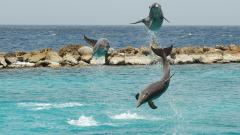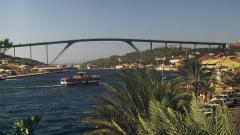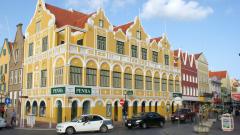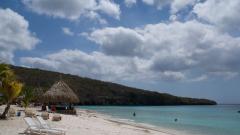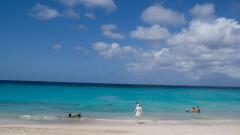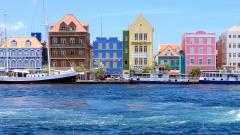 travel to Curaçao
travel to Curaçao
GENERAL CHARACTERISTICS
Curaçao or Island of Curaçao has an area of around 444 km², which includes some 138.000 inhabitants. It is located south of the Caribbean Sea, about 50 km away from the coast of Venezuela, and together with its neighboring islands of Aruba and Bonaire forms the archipelago of the Leeward Islands. Curaçao can be divided in two, the upper part, Banda Ariba is flatter. In this area you will find the airport, and the largest number of resorts and accommodations. On the other hand, Banda Abao, the lower part, is characterized by its green sinuosity and steep landscapes. Its capital and most populated city is Willemstad, known as the Caribbean Amsterdam.
The currency of legal tender is the guilder of the Netherlands Antilles, although the US dollar circulates freely and is accepted in all commercial transactions.
The official languages are Dutch, inheritance of the already dissolved Netherlands Antilles and Papiamento, which is spoken by 85% of the population, mixed Spanish, French, Indian awarak and Afro-Portuguese, also has official status in Aruba and Bonaire, although with slight regional variations. Spanish and English are also widespread throughout the territory.
The climate on the island is stable, semi-arid because it is located further from the influence of hurricanes and tropical storms, it reaches on average between 27°C and 30°C, always staying above 20°C. The rainy season is short, occurring from October to December. Humidity is another noteworthy aspect, since, throughout the year, it remains constant, always around 80%.
HISTORY
The island was formed thanks to the crash of two tectonic plates, as a result, the territory emerged to the surface.
In pre-Columbian times, it is thought that the tribe of Caquetíos, were the first inhabitants of Curaçao.
Later, in 1499, the island was opened to the world, after being discovered by the Spaniards in that year. It is believed that they baptized it as "The Heart Island", that denomination originated the country actual name. The territory remained under its control until the Dutch conquest in 1634, which together with the Sephardic Jews that arrived from Spain and Portugal, made the country a strategic point in the international trade of raw materials and slaves, placing it as one of the largest warehouses from the Caribbean. In 1807 the island was conquered by British troops, who remained in the territory until 1815, when the Dutch regained its control.
At the beginning of the XX century, oil deposits were discovered that motivated the construction of a large refinery in the capital, which represented a new economic boost for the country after the abolition of slavery. This incipient development motivated the arrival of new workforce of African, Arab and Asian origin. In 1954 it became an independent territory under the jurisdiction of the Netherlands and became part of the Netherlands Antilles, which, after a referendum proposed on all the islands, ended up dissolving in 2010. Today it is an autonomous territory, although under Dutch control. Economically, it focuses its activity on oil refining, banking transactions and tourism.
TOURISM
In recent years it has been established as a rising destination, thanks to the cruise industry, although it has also been affected by the Venezuelan political instability.
The island offers multiple options, Willemstad stands out for its colorful colonial architecture with European influences, which has served to be recognized by UNESCO as one of the six World Heritage cities of the Caribbean. The port was also awarded by this entity. The capital can be separated into two neighborhoods separated by La Bahia de Santa Ana, Punda and Otrobanda, both connected by the Queen Emma Bridge.
The most interesting points begin with the Brion Square, the Kura Hulanda Museum, the Rif Fort in Otrobanda; the Governor's Palace, the Floating Market, the Postal Museum, the Maritime Museum, Jojo Correa Square, the Jewish Synagogue, Wilhelmina Park Square and Fort Waterfort and Fort Amsterdam in Punda.
Among its natural attractions highlight for its wonderful beaches, with turquoise waters and an impressive seafloor, which make it a reference destination for diving in the Caribbean. However, you can also relax or do countless activities, boat trips, windsurfing, kayaking, snorkeling, scuba diving ... Among the most important beaches are: Mambo Beach, Kenepa Beach, Porto Marie Beach, Jan Thief Beach, Kalki Beach or Cas Abao Beach. In addition, you can enjoy other sports such as, cycling, horseback riding, golf, at the Old Quarry Center, or swimming with dolphins at the Dolphin Academy.
The Christoffel National Park is the largest natural reserve on the island, serving as a refuge for pelicans, flamingos and other 250 species of tropical birds. You can go on foot, by quad or jeep through a guided tour. Beside it is the National Park of Shete Boka or Seven Bays, although in reality it has ten. Between all bays, form a steep lunar landscape that is accompanied by the sound of the waves. Its beaches host three different species of sea turtles.
The Hatok Caves, located north of the capital, have huge stalactites, underground lakes of great beauty, waterfalls and a colony of bats.
Close to San Nicolás is Mushroom Forest '. This dive site is a network of caves and tunnels inhabited by exotic fish and turtles. The Porto Marie Valley is also an attractive place for diving, where you can admire the existing marine life. In 1984, the Seaquarium was created, the complex has become an important tourist destination. There, tourists can appreciate the diversity of the inhabitants of the underwater world, feed and touch turtles and rays, enjoy the museum's collection and dive.
The carnival is one of the most extensive and beautiful in the Caribbean. It begins at the end of January until mid-February, during this period, two important parades take place, accompanied by costumes and marching bands. Beauty contests are held, and there is a multitude of activities for all ages.
Next, we must mention its eventful nightlife with various clubs, especially, the largest concentration of entertainment venues is in the center of Willemstad in the Punda neighborhood. There are also restaurants and casinos where we can witness local kindness, entertain and enjoy music and local cuisine.
Finally, we can assure you that Curaçao is a fantastic destination that offers to the visitors an unforgettable experience, and the possibility to enjoy of relax time, sports, adventure, night entertainment and colonial structures, inside of a beautiful and unique natural environment, with a Caribbean-European mix, which is a mirror image of all the cultures that have inhabited it and from which it has taken advantage to receive tourists with the best of their smiles.
practical information
useful information before leaving
Language
Religion
Political regime
Currency
Warnings
Documentation
Vaccines
recommendations
Recommendations before traveling to Curaçao
- Avoiding the rainy season, the rest of the year the weather is dry and hot, it is ideal for sun and beach tourism. If you plan to tour the city, use plenty of sunscreen to avoid the intense rays of the sun, it is recommended to visit the island in September or May, when the climate is cooler.
- It is also advisable to wear light and comfortable clothing, use repellent in your uncover body parts and mosquito nets to ward off mosquitoes. They can be transmitters of dengue, chikungunya or zika virus, In case of emergency dial 9345.
- The island is quite safe, but it is not advisable to explore some peripheral areas. In public places we should monitor our personal belongings closely, especially in the most populated areas and on the beaches. We also advise, leaving valuables must be stored in the hotel safe.
- The most known credit cards are accepted in almost all commercial premises.
- The export of cultural goods is strictly prohibited, so that divers cannot leave the country and must deliver any relic they find during the dives to the authorities
- The water of Curaçao is not only safe, but it has an excellent quality.
- Shops open at 8:30 or 9:00. They close at 6:00 p.m. The restaurants have their kitchen open until 10pm. approximately.
- Some beaches are private and charge for admission and also charge a fee for using extra services such as the use of beach chairs or shower.
- Public transport is perfectly regulated with stops (bushalle) throughout the island.
- The international prefix is +5999. All local telephone numbers have seven digits.
- Saint Elisabeth Hospital is the largest hospital in Curaçao and the best equipped, has the only intensive care unit on the island. In addition, you will have the possibility to go to one of its two private clinics.
- The voltage of the network is variable 127/120 V and 50Hz. You must have an adapter to plug in your electronic devices. In most hotels these are available upon request.
- To contact the Police and the Fire Department we will dial 911, to warn the ambulance to dial 912, in case of Tourist Emergency we must contact 917, and if we have a maritime emergency we must go to the Coast Guard, available in the 913.
regions of Curaçao
Know all the zones and cities that you can discover in your trip

